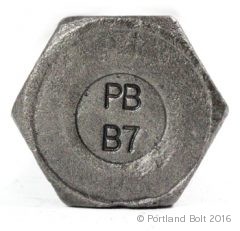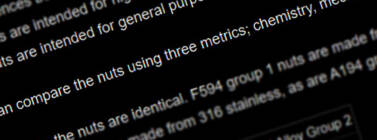What is the difference between F3125 Grade A325 structural bolts and A193 Grade B7 bolts?
 A325 and A193B7 bolts are among the most common, mass-produced bolts available in the marketplace. It is a common misconception that these bolts are interchangeable since they have a lot of similarities in their configurations, and both are considered high-strength bolts. In fact, these bolts have two very different applications and have differences in their chemical and mechanical properties.
A325 and A193B7 bolts are among the most common, mass-produced bolts available in the marketplace. It is a common misconception that these bolts are interchangeable since they have a lot of similarities in their configurations, and both are considered high-strength bolts. In fact, these bolts have two very different applications and have differences in their chemical and mechanical properties.
Application
A325 bolts are specifically designed for use in structural connections. The bolts have a heavy hex head, a full body diameter and are normally short in the overall length since they are used to connect steel to steel. A325s also have fixed thread lengths that are shorter than typical standard thread lengths. Because of their application, A325 bolts must always have a forged head in order to meet the specification. These bolts can be manufactured in diameters 1/2″ through 1-1/2” in diameter.
A193 bolts are designed for high-pressure, high-temperature applications. They are commonly found on pressure vessels and pipe valves. These bolts are typically heavy hex bolts or fully threaded studs, though there is not a configuration limitation like there is with A325 bolts. A variety of bent bolts, rods with threads on one end or both ends, and headed bolts other than heavy hex are commonly manufactured under the A193B7 specification. The diameter range available in this specification is 1/4″ through 7” in diameter.
Chemical and Mechanical Properties
The tables below show the differences between these two grades in their chemical and mechanical properties. Most notably, A193B7 has higher mechanical properties and the chemical properties are different since they are often made from different types of steel.
A325 Type 1 Chemical Properties
| Heat Analysis | 120ksi, % | 150ksi, % |
|---|---|---|
| Carbon | 0.30 – 0.52 | 0.30 – 0.48* |
| Manganese | 0.60 min | 0.60 min |
| Phosphorus | 0.035 max | 0.035 max |
| Sulfur | 0.040 max | 0.040 max |
| Silicon | 0.15 – 0.30 | - |
| Boron | 0.003 max | 0.003 max |
| Copper | - | - |
| Nickel | - | - |
| Chromium | - | - |
| Molybdenum | - | - |
| *Carbon 0.35-0.53% for 1-1/2” A490/150ksi bolts | ||
A193 Chemical Properties
| Element | B7 (AISI 4140) | B8 (AISI 304) | B8M (AISI 316) |
|---|---|---|---|
| Carbon | 0.38 - 0.48% | 0.08% max | 0.08% max |
| Manganese | 0.75 - 1.00% | 2.00% max | 2.00% max |
| Phosphorus, max | 0.035% | 0.045% | 0.045% |
| Sulfur, max | 0.040% | 0.030% | 0.030% |
| Silicon | 0.15 - 0.35% | 1.00% max | 1.00% max |
| Chromium | 0.80 - 1.10% | 18.0 - 20.0% | 16.0 - 18.0% |
| Nickel | 8.0 - 11.0% | 10.0 - 14.0% | |
| Molybdenum | 0.15 - 0.25% | 2.00 - 3.00% |




For less common sizes, can F3125 A325 bolts be machined from ASTM A193 B7 bar stock?
@Andrew- You can use that base material, but you would still need to perform the mechanical testing after manufacture to make sure the finished fastener meets the published requirements.
Is the strength of a B-7 all thread T-Rod 1″-8 equal to or greater than the strenght of an 1″ A325.bolt?
I ask because I want to substitute B-7 all thread for a A325 bolt. There is a point of interference on three points of a tower we have stacked and we can’t fit the A325 bolts on three connection point on a flange because the head of the bolt will not fit.
Do you sell 1″ all thread A325 rods? I need 3′ in order to fabricate 3 all thread bolts.
thanks
@Tim- The mechanicals of B7 and A325 are very similar, but not exactly the same. There are performance differences between headed bolts and threaded rods in some applications, so an engineer should be consulted before any substitutions are made. We are unable to sell A325 threaded rods because the A325 standard only covers headed bolts. A193 B7 or A449 threaded rods are the closest equivalents if you choose to make that substitution.
Please see attached NMDOT Detail for anchoring a pre-cast Concrete Wall Barrier (CWB) to a Bridge Deck 9″ thick. The anchoring details calls for
A-325 7/8″ High Strength Glavanized Bolts – anchoring it with a debonding agent and epoxying it with an embedment length recommended by the manufacturer.
This anchorage is temporary to build the 2nd phase of the bridge to protect traffic from the drop-off.
NMDOT DRawing is 606-20-3/5 – also available on NMDOT Website. The holes are going to be every 5′ for 10′ CWB.
I need your recommendation for
1. Embedment Length for 7/8″ A325 Bolts
2. Type of Epoxy and De-bonding agent
These bolts will be pulled out after 2nd phase of the bridge is connected to the 1st phase Bridge and the holes will be filled with non-shrink grout.
Lastly, can B-7 bolts be substituted for A-325?
Thanks in advance for your quick response and contact information for your local dealer.
phone number is 505-270-1437
Taj Engineering Consultants, Inc.
@Sayeed- We are able to manufacture a special A325 bolts, but we do not typically handle epoxy and don’t have the knowledge to make any recommendations as far as type of epoxy or embedment length. As far as substituting B7 for A325, that is something you’d need to take up with the project engineer.